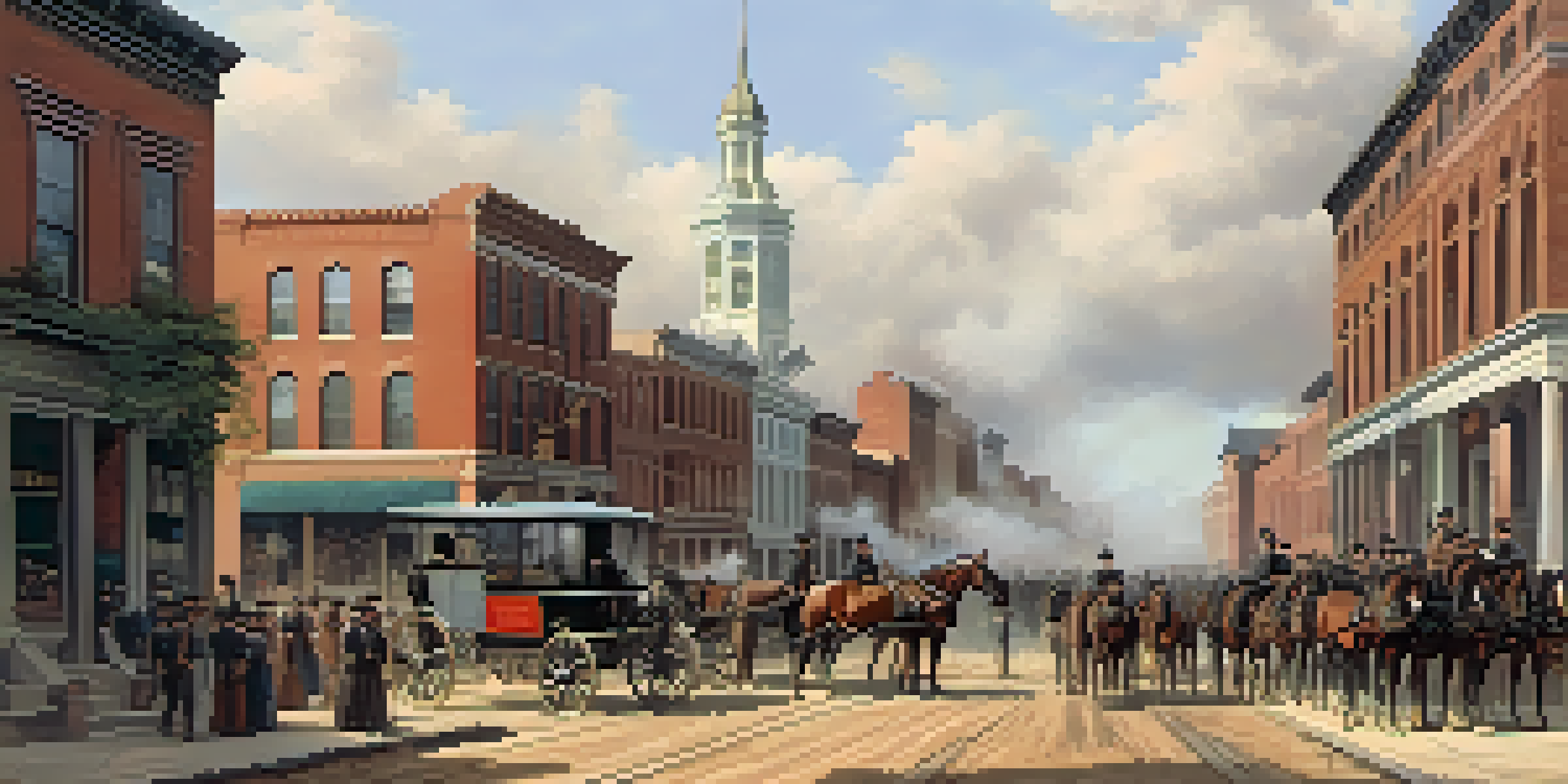St. Louis in the Civil War: A Divided City

Introduction: St. Louis on the Brink of War
As the Civil War loomed over the United States, St. Louis found itself in a precarious position. The city, with its strategic location along the Mississippi River, was a vital military and logistical hub. Its population was a mix of Unionists and Confederates, creating a social fabric that was as rich as it was tense. This backdrop made St. Louis a microcosm of the national conflict brewing across the country.
A house divided against itself cannot stand.
People in St. Louis were divided not just by their allegiances but also by economic interests, cultural ties, and family connections. For many, the war was not just a political issue; it was a matter of personal loyalty and identity. As the state of Missouri teetered between Union and Confederate control, St. Louis became a focal point for both sides. The stage was set for a tumultuous chapter in the city’s history.
Understanding the dynamics of St. Louis during this period helps us grasp the broader implications of the Civil War. The city’s experience reflects the complexities faced by many urban centers at the time. With tensions rising, the question remained: which side would ultimately prevail in this divided city?
The Strategic Importance of St. Louis
St. Louis was more than just a city; it was a gateway to the West. Its location made it crucial for both Union and Confederate forces looking to control key supply routes. The city housed significant military resources, including arms, ammunition, and a well-connected railroad system. This strategic value turned St. Louis into a target for both sides as they sought to gain the upper hand in the war.

For the Union, controlling St. Louis meant ensuring the security of the western front and maintaining supply lines. Conversely, the Confederates aimed to seize the city to disrupt Union operations and bolster their own military presence. This tug-of-war manifested in skirmishes and political maneuvering, as each side sought to assert its dominance. St. Louis became a chessboard where the stakes were life and death.
St. Louis: A Civil War Hotspot
St. Louis's strategic location made it a critical battleground for both Union and Confederate forces, reflecting the city's divided loyalties.
Moreover, the city's strategic importance was not just military; it also had profound implications for the civilian population. The constant threat of conflict created an atmosphere of uncertainty and fear. As the war progressed, residents found themselves grappling with the reality of living in a city that was both a battleground and a home.
The Role of the Federal Government
As tensions escalated, the federal government recognized the necessity of maintaining control over St. Louis. In 1861, the Union Army established a strong military presence in the city, which included fortifying key locations and securing vital resources. This military occupation aimed to quell dissent and ensure the loyalty of the population. However, it also heightened local tensions, with many residents feeling the weight of federal oversight.
In war, there are no unwounded soldiers.
The federal government's actions in St. Louis were often met with resistance from Confederate sympathizers. Secret societies emerged, and acts of sabotage became increasingly common as individuals sought to undermine Union efforts. The situation escalated to the point where St. Louis became a hotbed of espionage and intrigue, with both sides employing spies to gather intelligence and disrupt operations.
Despite the challenges, the federal government's commitment to St. Louis ultimately played a pivotal role in shaping the city's future. By asserting control and providing resources, the Union aimed to not only win the war but also to secure St. Louis's allegiance. This period of military governance marked a significant turning point in the city’s history, setting the stage for the eventual resolution of the conflict.
Civil Unrest: Riots and Clashes
With its divided loyalties, St. Louis was no stranger to civil unrest. Tensions often boiled over into violence, resulting in riots and clashes between rival factions. Notably, the 1861 'Camp Jackson Affair' marked a pivotal moment when Union troops attempted to disarm Confederate militia, leading to violent confrontations in the streets. This incident not only showcased the city’s explosive atmosphere but also solidified the divisions within the community.
The riots that followed illustrated the deep-seated animosities that existed among the populace. Families and friends found themselves on opposite sides of the conflict, leading to devastating personal rifts. These clashes were not merely political; they involved real human emotions, with people fighting for their beliefs and their communities. The violent aftermath left scars that would take years to heal.
Civil Unrest and Community Strife
The tensions in St. Louis often erupted into riots and violence, illustrating the personal and societal rifts caused by the Civil War.
These moments of unrest also drew national attention, highlighting St. Louis as a city in turmoil. The media reported extensively on the violence, framing the events as symbolic of the larger national struggle. As the war dragged on, the events in St. Louis served as a reminder of the personal toll that the Civil War exacted on cities and their residents.
The Impact on Daily Life
Life in St. Louis during the Civil War was marked by uncertainty and hardship. Residents faced food shortages, inflated prices, and rampant inflation as the war disrupted trade routes. The constant military presence altered daily routines, with soldiers patrolling the streets and checkpoints becoming commonplace. This atmosphere of vigilance transformed ordinary life into a struggle for stability.
Families had to navigate the complexities of divided loyalties, with some members supporting the Union and others backing the Confederacy. Social gatherings became fraught with tension, as discussions about politics could easily ignite arguments or worse. Many residents sought solace in community organizations, which provided support and resources amid the chaos, but the emotional toll was undeniable.
As the war dragged on, the impact on daily life became more pronounced. Schools, churches, and businesses adapted to the changing landscape, often prioritizing survival over normalcy. This resilience in the face of adversity characterized the spirit of St. Louisans during the Civil War, showcasing the strength of community bonds even in the darkest of times.
Post-War Reconstruction and Reconciliation
Following the end of the Civil War, St. Louis faced the daunting task of rebuilding and reconciling a divided community. The scars of conflict ran deep, and the process of healing required both time and effort. Reconstruction efforts focused not only on physical infrastructure but also on mending the social fabric torn by years of strife. The city’s leaders recognized that a united front was essential for progress.
The post-war period also saw significant changes in governance, as the federal government sought to integrate former Confederate states back into the Union. St. Louis witnessed a surge in political activism as citizens engaged in discussions about their future. Many sought to redefine their identities in a rapidly changing landscape, navigating the complexities of loyalty and belonging in a city still grappling with its past.
Reconstruction and Healing Process
Post-war St. Louis faced the challenge of rebuilding and reconciling a community deeply scarred by conflict, emphasizing the need for unity and understanding.
Ultimately, the journey toward reconciliation was long and fraught with challenges. However, St. Louis emerged from the Civil War with a renewed sense of purpose. The lessons learned from this tumultuous period would shape the city’s identity for generations to come, serving as a reminder of the importance of unity and understanding in the face of adversity.
Legacy of a Divided City
The legacy of St. Louis during the Civil War continues to resonate today. The conflicts and divisions of that era have left an indelible mark on the city’s identity, informing its cultural and social dynamics. Understanding this history is crucial for appreciating the complexities of modern St. Louis, a city that has evolved but still carries the echoes of its past.
The stories of those who lived through this turbulent time serve as powerful reminders of the resilience and strength of communities in the face of division. Many sites in St. Louis, including museums and monuments, commemorate this history, ensuring that the lessons learned are not forgotten. These sites act as a bridge between past and present, inviting reflection on the impact of conflict on society.

As we look back at St. Louis in the Civil War, we are reminded of the importance of dialogue, empathy, and understanding in overcoming division. The city’s journey from conflict to reconciliation offers valuable insights into how communities can heal and grow, making it a relevant case study for today’s social landscape.